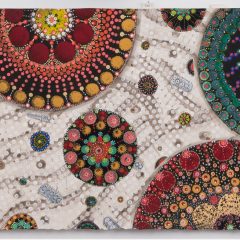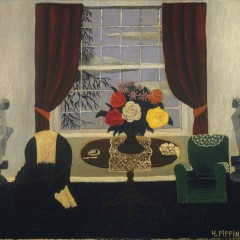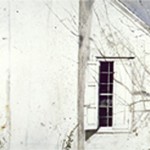My neighbor, Pam, invited me to go with her to the Brandywine River Museum, a place I’ve never been, a museum that houses the Wyeth family art and, so we thought, a temporary exhibit pairing works of Andy Warhol and Jamie Wyeth. As it turned out we had missed the Warhol/Wyeth (and Basquiat!) exhibit by a couple weeks and were pretty bummed about that. We also were a little flumoxed to find ourselves at the museum at a time when it was jam-packed with groups visiting the yearly blockbuster exhibit, A Brandywine Christmas, which includes a miniature train exhibit, tons of hand-made ornaments and Christmas trees throughout.
But there we were and so we tried to avoid the crowds and wandered among the Wyeth rooms instead which were almost empty compared to the ruckus elsewhere in the musuem.
Royal Lacey Scoville’s The Dream of Tom Thompkins
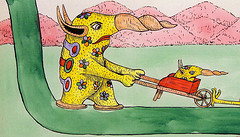
Here laboring to wheel across
His bright young Hopeful in a barrow
We see the stern Shampoot-er-os
To tell whose deeds would freeze your marrow.
But when we entered the holiday galleries we actually hit pay dirt with an exhibit of antique children’s book drawings — never before shown — by a self-taught gentleman and weekend-painter from Pittsburgh, Royal Lacey Scoville. Scoville, as good as any professional children’s book illustrator, had made a fantasy children’s project for his nine-year-old daughter, Eleanore, that included a nonsense poem and watercolor illustrations. But he never finished the project and the drawings –never published because that wasn’t the point — stayed in the family until last year when Scoville’s grandsons (Eleanore’s sons) donated them to Brandywine River Museum. The museum–which knows from children’s book illustrations, having a hefty collection of N.C. Wyeth’s, understood that its new treasure — even though unfinished — would be a great book, and so they published it under the imprint, Brandywine Conservancy.
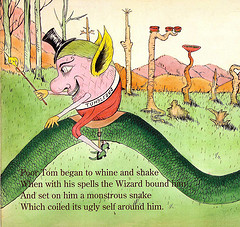
The Wizard Tumblebug
So who was Scoville? He was a prosperous and successful broker in Pittsburgh who also had a gift of the imagination. He could draw and paint–and he was a wood carver. Several carved decorative boxes he made are on display at Brandywine along with the drawings and they show the same mind at work. He was an amazing fantasist, akin to both Edward Lear* and L. Frank Baum, although Scoville is more of a visual artist than a wordsmith. His nonsense rhymes are a little tortured and less poetic than Lear’s. But that’s a minor complaint because the drawings are fully realized and beautiful and feel completely fresh–their sensibility is as contemporary as tomorrow’s children’s book.
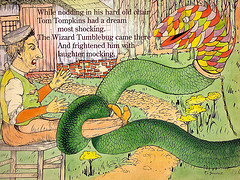
Tom Tompkins’ dream of being set upon by a monstrous snake.
The nonsense poem that drives The Dream of Tom Thompkins introduces an evil wizard, a snake, an innocent napping victim and a parade of characters that are human/animal hybrids. And the artist clearly revels in his creations which are lovingly depicted down to their eyelashes and curled-up lips.
The snake’s improbably-long body becomes the playground for the display of the wacky creatures, each one given a nonsense name which mostly riffs on animals and objects but in one case refers to the Pittsburgh suburb of Sewickley (The swift Se-wick-leyian Loop-the-loopers). Mostly the names don’t do much for the awesome characters but then I’m not a 9-year-old. Perhaps the Corrugated Bingalo is a name a child would find mysteriously wonderful, children being themselves creatures who are obsessed with naming things.
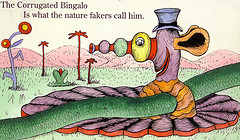
The Corrugated Bingalo
You can tell Scoville was completely enraptured by his creations. The detailed patterning on their bodies, the convincing psychological completeness of their expressions (like the stern Shampoot-er-os, a bipedal rhino that looks like something out of Yellow Submarine) are lovingly done. And while one character, the Quad-ri-wheeleon, a multi-hump camel with a face like an African mask and wheels instead of feet, reminded me of L. Frank Baum’s Wheelies in Ozma of Oz, mostly the creations feel completely new.
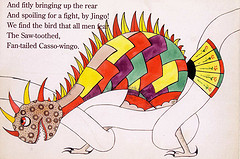
The Saw-toothed, Fan-tailed Casso-wingo bird. Unfinished page.
The book ends with Tom Thompkins, having been astonished beyond belief, vowing never to nap again!
The snake, the background and foreground are washy color fields that are simply there to give credence to the characters, although as the book goes on the detail peters out on those background elements so I have to guess that Scoville simply never finished — he didn’t add the blades of grass to the green foreground, didn’t add brush and trees to the pink mountains and hadn’t the time/energy to put in the scales on the snake. No matter, the creatures are divine and they kept me looking — and turning the pages of the book.
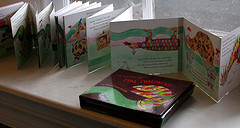
Book with its accordian layout and box.
Speaking of the book the museum published: It’s nicely designed with the text/illustration pages accordian-folded and tucked in a pocket inside a hard-bound cover that closes with a velcro button. At $8.95 it’s a classy item and both Pam and I bought one.
——————
* When my son, Max, was in pre-school at Moonstone, a wondrous place if ever there was, the kids all were taught to learn Edward Lear’s The Owl and the Pussy Cat by rote. So of course I learned it too, just to keep up. It’s a magical dreamy bit of doggeral that to this day makes me smile. Here’s the first verse:
The Owl and the Pussy-Cat went to sea
In a beautiful pea-green boat:
They took some honey,
and plenty of money
Wrapped up in a five-pound note.




